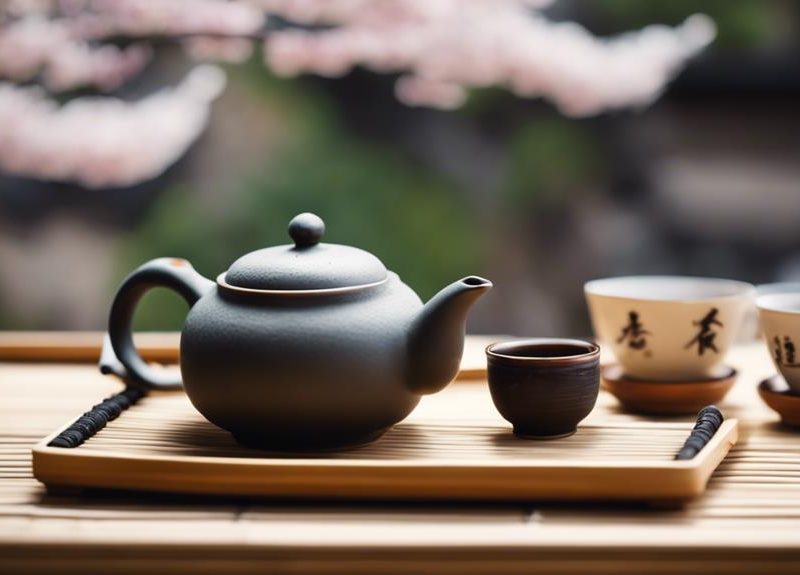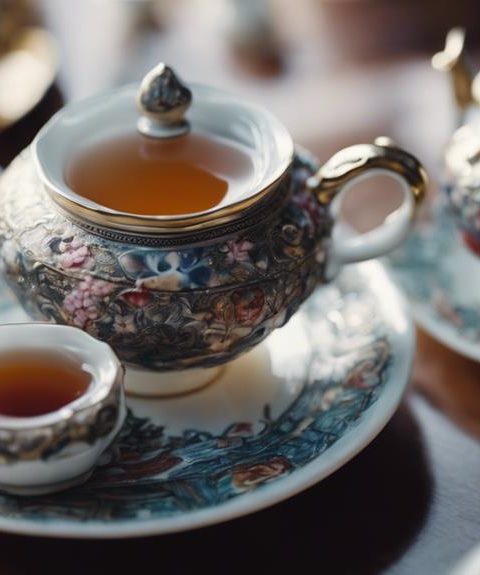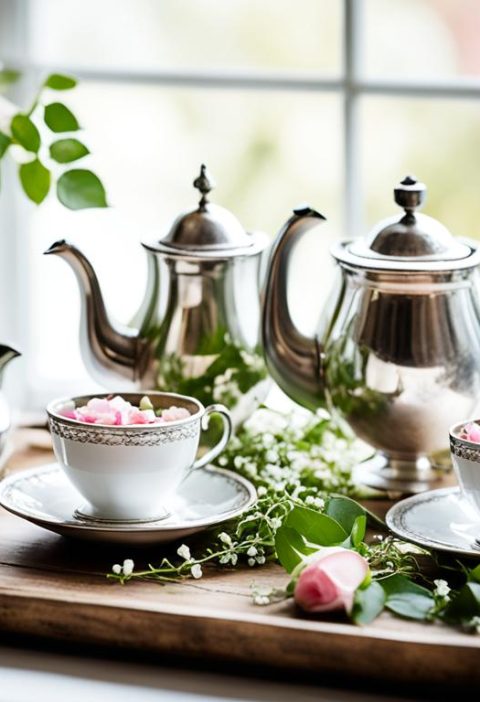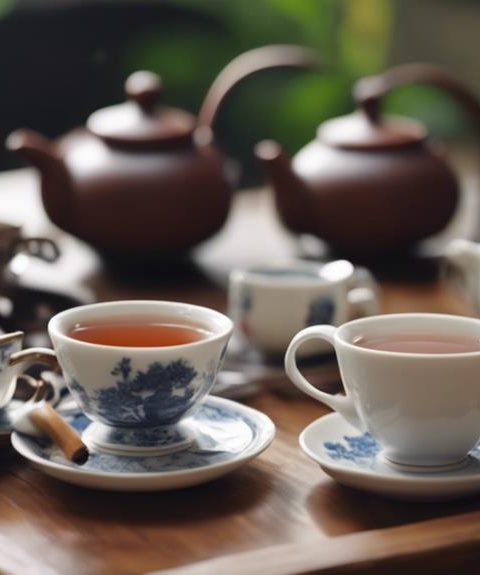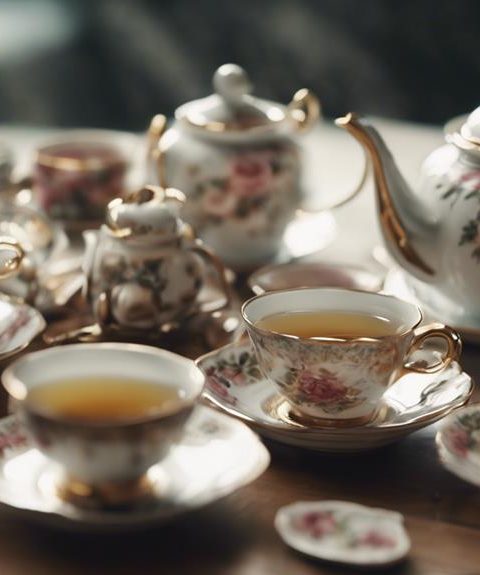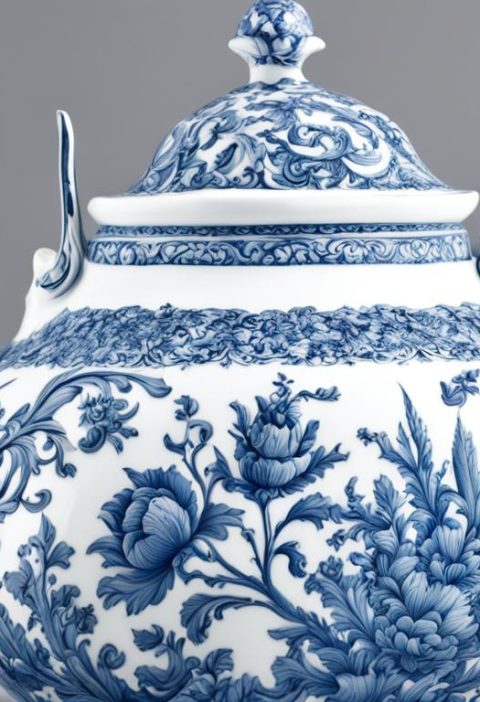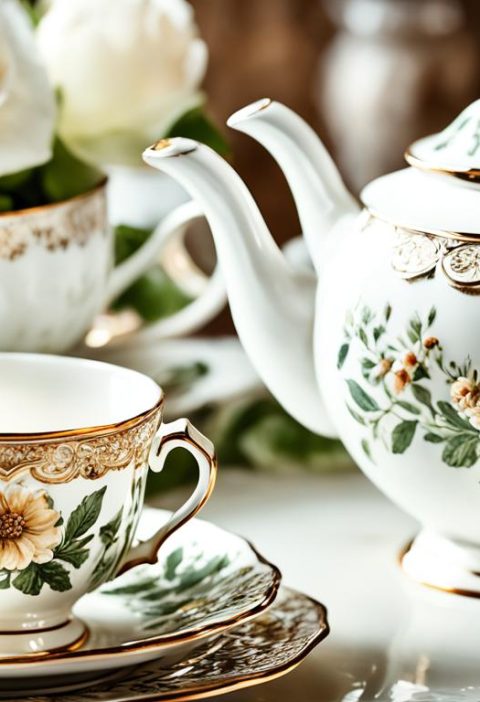Explore the exquisite world of Japanese tea sets, encompassing a wide array of designs and styles, including the intricate Kyusu teapots and unique regional variations. These tea sets epitomize a blend of harmony and aesthetics, elevating the act of enjoying tea. Crafted meticulously by skilled artisans, each Kyusu teapot seamlessly merges functionality with graceful elegance, reflecting deep-rooted cultural traditions. The artistry and symbolism infused in Japanese tea sets offer a visual delight inspired by nature and rich heritage, inviting you on a journey of cultural exploration.
Delve deeper into the realm of Japanese tea sets beyond Kyusu to uncover a tapestry of diverse designs influenced by different regions, each contributing to the rich tapestry of tea culture. Embrace the profound cultural significance and masterful craftsmanship that these tea sets embody, bridging the gap between tradition and innovation. Immerse yourself in the beauty of these artistic creations and appreciate the heritage they represent.
Whether you are a seasoned tea connoisseur or a curious explorer, Japanese tea sets hold a world of wonder waiting to be discovered. Enhance your tea-drinking experience and connect with centuries-old traditions through these exquisite works of art that celebrate the beauty of Japanese craftsmanship.
Key Takeaways
Kyusu teapots, Bizen ware, and Kutani tea sets exemplify the rich tapestry of design evolution in Japanese tea culture. Japanese tea sets harmoniously blend traditional grace with contemporary aesthetics and materials, showcasing a fusion of artistic elements like colors, shapes, and symbolism. Exploring diverse regional variations beyond Kyusu, such as Bizen ware and Kutani tea sets, provides a deeper appreciation for the cultural nuances and design intricacies embedded in each piece. Collecting these Japanese tea sets not only offers a glimpse into the evolution of design but also serves as a gateway to understanding and cherishing the cultural heritage they represent.
Tea Culture in Japan
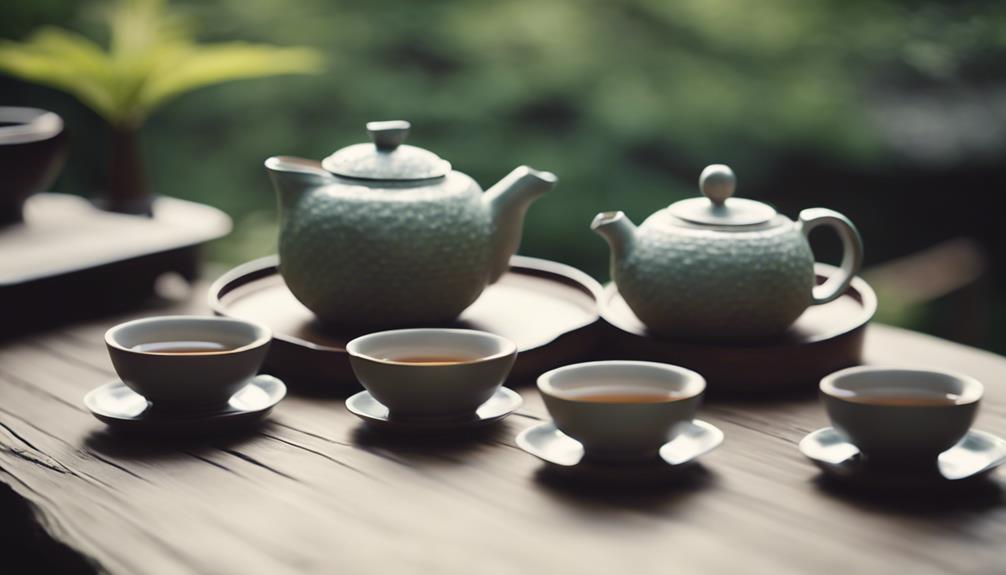
Japanese tea culture is deeply intertwined with tradition and history, with tea ceremonies embodying harmony, respect, purity, and tranquility. The art of tea preparation, known as 'chanoyu' or 'the way of tea,' holds a revered position in Japanese society.
Tea ceremonies, referred to as 'chado,' go beyond just the act of drinking tea; they're moments of peace and connection. Every aspect of the ceremony, from the delicate whisking of the tea to the graceful serving process, is intentional. The focus isn't only on the tea's flavor but also on creating a harmonious aesthetic and ambiance.
The essence of Japanese tea culture extends to the design of tea sets, where each component serves a specific function to elevate the tea-drinking experience. From the intricately crafted teapots to the elegant tea bowls, every piece is meticulously made to honor Japan's centuries-old tea tradition.
Origins of Kyusu Teapots
Exploring the origins of Kyusu teapots unveils a fascinating journey of design evolution and the development of unique regional variations over time. These teapots boast a rich history, adapting to diverse brewing styles and preferences.
Understanding the roots of Kyusu teapots illuminates their significance in Japanese tea culture, reflecting the cultural nuances and craftsmanship involved in their creation.
From the traditional Tokoname and Banko styles to modern interpretations, Kyusu teapots have evolved to cater to the discerning tastes of tea enthusiasts worldwide.
Kyusu Design Evolution
The evolution of Kyusu teapots in Japanese tea culture and craftsmanship spans centuries, reflecting a rich history of innovation and tradition. Originally, Kyusu teapots were simple vessels crafted from unglazed clay, prized for their functionality and practicality.
Over time, artisans began experimenting with various shapes, sizes, and materials, resulting in the creation of distinctive styles like Yokode Kyusu (side-handled teapots) and Ushirode Kyusu (rear-handled teapots). These design advancements not only improved the tea brewing process but also added aesthetic appeal to the teapots.
The continuous refinement of Kyusu design exemplifies the intricate balance between honoring tradition and embracing innovation in Japanese tea culture.
Regional Kyusu Variations
Kyusu teapots, originating from various regions in Japan, showcase a rich tapestry of design variations that embody the diverse cultural influences and unique craftsmanship practices of each area. These regional nuances in Kyusu teapot designs offer a captivating journey through the intricate world of Japanese tea culture.
The Banko Kyusu from Yokkaichi stands out with its exquisite carvings and the use of reddish-purple clay indigenous to the region, showcasing a blend of artistry and tradition. In contrast, the Tokoname Kyusu from Aichi is celebrated for its elegant simplicity and high-fired stoneware, embodying a refined aesthetic appeal. As we move towards the east, the Tokoname region presents Kyusu pots characterized by earthy tones and minimalist charm, while the Iwate prefecture offers a more rustic and traditional style, emphasizing a connection to heritage.
Each unique regional variation of the Kyusu teapot tells a compelling story of lineage and craftsmanship, enriching the tapestry of Japanese tea culture with a depth of tradition and artistry that transcends time.
Kyusu: Function and Form
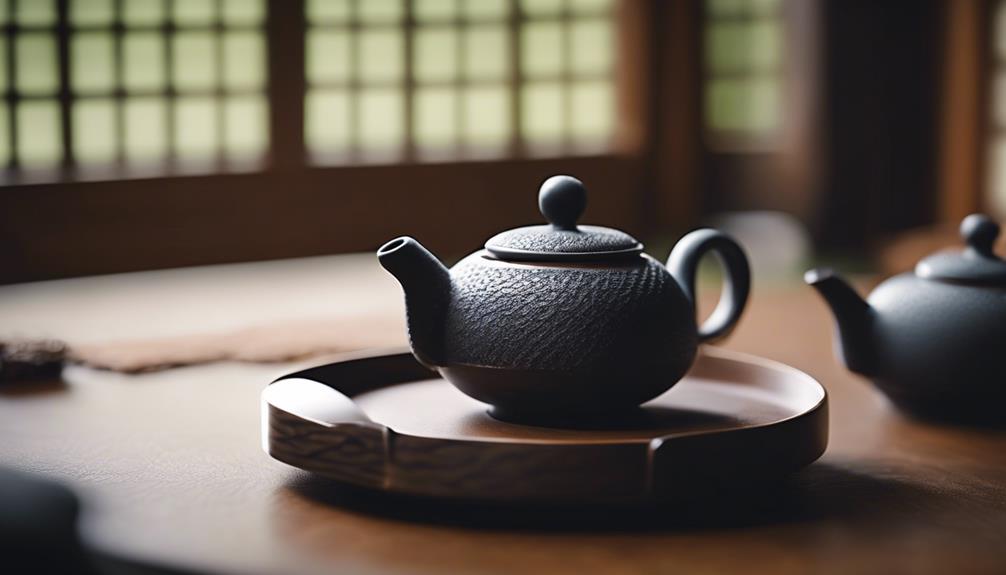
The kyusu teapot, with its centuries-old history, represents a harmonious fusion of functionality and elegance in traditional Japanese tea ceremonies. Crafted with meticulous care by skilled artisans, the kyusu embodies the essence of Japanese culture and artistry, making it a beloved symbol in the world of tea.
Craftsmanship shines through in each kyusu, where form and function come together in perfect harmony. The intricate details in its design, from the curves to the handles, showcase a deep reverence for the tea-making process, inviting admiration for the artistry involved in every pour.
The kyusu's shape is purposefully crafted to enhance the brewing experience, ensuring a well-balanced infusion of flavors with each steep. Holding the kyusu in your hands evokes a sense of tranquility as you feel the unity between the teapot's form and the tea it holds, creating a serene moment in the ritual of pouring.
Drawing inspiration from nature, many kyusu designs feature motifs like leaves, waves, or flowers, establishing a profound connection to the natural world. This connection fosters a feeling of mindfulness and serenity, encouraging tea drinkers to savor each sip in harmony with their surroundings.
Types of Japanese Tea Sets
Japanese tea sets showcase a wide array of choices, encompassing both traditional and modern designs, each offering its unique allure. These sets, crafted from diverse materials and featuring intricate designs, play a crucial role in shaping their visual appeal and practicality.
Traditional tea sets exude a sense of cultural heritage and elegance, while modern interpretations infuse a touch of contemporary flair into the tea-drinking experience. The choice of materials, such as porcelain, ceramic, or cast iron, along with the designs, whether minimalist or intricately detailed, contribute to the overall aesthetic and functionality of these sets.
Traditional Vs. Modern
When exploring Japanese tea sets, you encounter a rich tapestry woven with the threads of traditional craftsmanship and modern design choices. Traditional tea sets serve as portals to bygone eras, imbued with history and cultural significance, inviting you to partake in centuries-old tea ceremonies. In contrast, modern tea sets embrace a sleek and minimalist aesthetic, resonating with contemporary sensibilities and a penchant for innovation.
The dichotomy between traditional and modern designs stirs a spectrum of emotions within you. Traditional styles evoke nostalgia, transporting you to a realm of reverence for heritage and tradition. On the other hand, modern aesthetics spark excitement, igniting an appreciation for cutting-edge design and the allure of the new and unexplored.
Whether you find solace in the familiarity of classic elegance or thrill in the avant-garde allure of modernity, there exists a tea set perfectly attuned to your personal style and preferences. Embrace the harmonious blend of the past and present as you delve into the world of Japanese tea sets, where history and innovation converge to create a truly captivating experience.
Materials and Design
In the realm of Japanese tea sets, a rich tapestry of materials and designs intertwines tradition and innovation.
From the classic elegance of porcelain sets adorned with intricate hand-painted motifs to the rustic charm of clay kyusu pots with their simple yet graceful shapes, Japanese tea sets offer a diverse array of options catering to various tastes.
Cast iron sets, prized for their robustness and heat retention capabilities, evoke a sense of tradition, while glass or modern ceramic sets infuse a contemporary flair into the age-old tea ceremony.
Each material, be it bamboo, ceramic, or cast iron, plays a vital role in both the visual appeal and functional aspects of Japanese tea sets, striking a seamless balance between heritage and modernity in the art of tea preparation and enjoyment.
Artistry in Tea Set Design
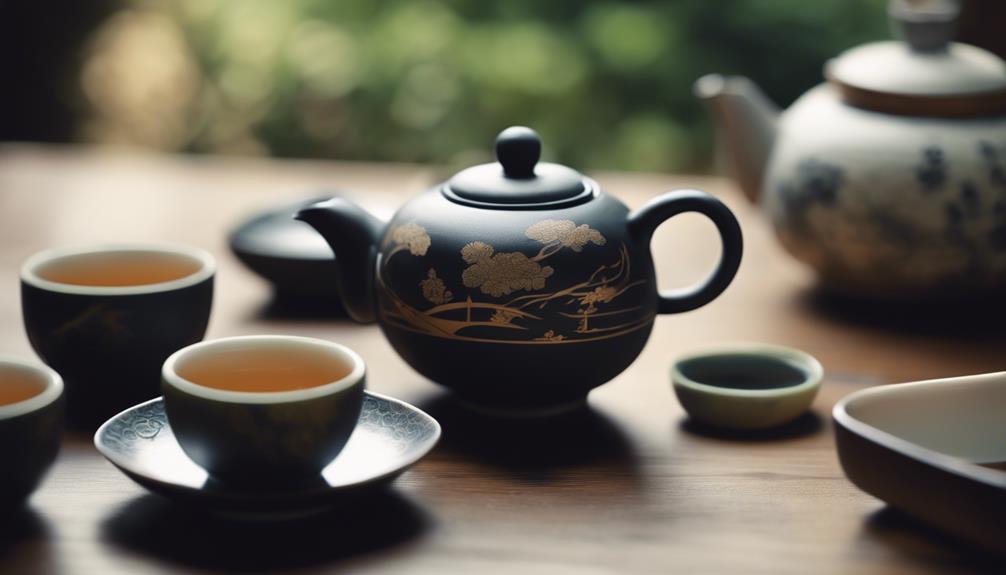
Admiring the intricate patterns and delicate craftsmanship of Japanese tea sets can transport you to a world of artistic beauty and cultural significance. Each tea set is a masterpiece in its own right, showcasing the skill and creativity of the artisans who crafted it. The attention to detail in every aspect of the design, from the shape of the teapot to the motifs painted on the cups, reflects a deep appreciation for aesthetics and tradition.
To evoke emotion in you, let's delve into the artistry of Japanese tea set design from different angles:
- Harmony of Elements: The seamless integration of colors, shapes, and textures in Japanese tea sets creates a harmonious visual experience and a sense of tranquility.
- Intricate Patterns: The elaborate patterns adorning Japanese tea sets, often drawing inspiration from nature or cultural symbols, encourage contemplation and admiration for the beauty in the world.
- Elegance in Simplicity: The minimalist yet refined designs of Japanese tea sets exude sophistication and elevate the act of tea-drinking to an art form.
When appreciating Japanese tea sets, one can immerse oneself in the blend of intricate details, cultural symbolism, and aesthetic harmony that make these objects not only functional but also profound works of art.
Symbolism in Tea Utensils
Exploring the symbolism found in Japanese tea utensils unveils a complex tapestry of cultural meanings and traditional values. Each component of a tea set goes beyond its practical function, reflecting a profound connection to nature, spirituality, and history. The materials used in crafting tea utensils, like clay for kyusu pots, symbolize the earth and its grounding properties, encouraging individuals to remain rooted in their origins. The shapes and colors of the utensils also hold significance, with curved lines representing harmony and balance, and colors such as green evoking the serenity of a vibrant tea garden.
Moreover, the intricate patterns adorning tea utensils often narrate tales from Japanese folklore or showcase seasonal themes, adding layers of symbolism to the tea ceremony. Even the manner in which utensils are handled and presented conveys meaning, underscoring values of respect, mindfulness, and appreciation. Understanding the symbolism woven into each tea utensil enhances one's admiration for the artistry and purpose infused into every facet of Japanese tea culture.
Beyond Kyusu: Unique Designs
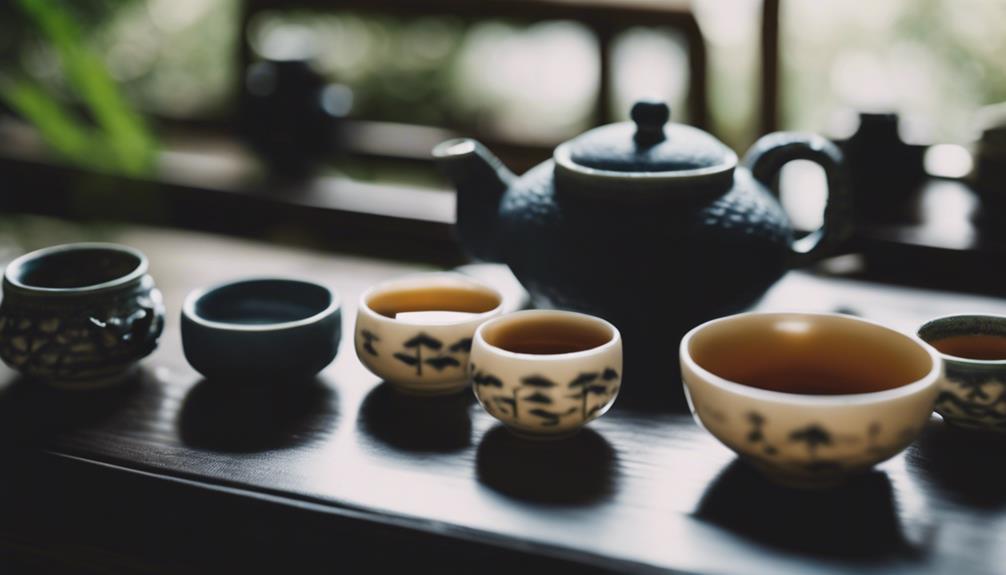
Contemporary Japanese tea set designs showcase a diverse range of innovative shapes and artistic flair, going beyond the traditional Kyusu. Modern artisans have ventured into creative realms to offer tea enthusiasts unique and visually captivating experiences.
Here are three outstanding examples that highlight the diversity of Japanese tea set designs:
- Sculptural Elegance: These tea sets are intricately crafted to mimic delicate cherry blossoms in full bloom, transforming each piece into a stunning work of art that brings nature's beauty to your tea table. The intricate details and graceful curves evoke tranquility and harmony, elevating the tea-drinking ritual into a serene experience.
- Minimalist Zen: Embodying simplicity and purity, this tea set features clean lines and a monochromatic color scheme that encourages focus on the essence of the tea ceremony. The understated elegance creates a serene ambiance, perfect for moments of mindful sipping and reflection.
- Futuristic Fusion: Blending traditional elements with a modern twist, these tea sets combine sleek metallic finishes with traditional motifs, capturing Japan's rich cultural heritage while embracing contemporary aesthetics. This design offers a refreshing take on classic tea sets, appealing to those who appreciate a fusion of tradition and innovation.
Tea Ceremony Essentials
Unveiling the intricate components that constitute a traditional Japanese tea ceremony involves exploring the symbolism embedded in each ritual object. This exploration enhances one's understanding and appreciation of this ancient practice. Let's delve into the essential tools that enrich the experience of the tea ceremony.
- Chawan (Tea Bowl):
- The chawan, or tea bowl, is a central element in the tea ceremony.
- It symbolizes simplicity, humility, and respect.
- The design and texture of the chawan can vary, adding depth to the tea-drinking experience.
- Chashaku (Tea Scoop):
- The chashaku, a bamboo tea scoop, is used to measure matcha powder.
- It signifies mindfulness and precision in the preparation of tea.
- Each chashaku is uniquely crafted, reflecting the artistry of the tea ceremony.
- Chasen (Tea Whisk):
- The chasen, or bamboo tea whisk, is essential for whisking matcha into a frothy consistency.
- It represents grace and fluidity in the tea-making process.
- The delicate craftsmanship of the chasen enhances the aesthetics of the ceremony.
- Natsume (Tea Caddy):
- The natsume, a small container for storing matcha powder, symbolizes elegance and containment.
- It showcases the importance of preserving the quality and freshness of the tea.
- The natsume is often adorned with intricate designs, reflecting traditional motifs.
- Futaoki (Lid Rest):
- The futaoki, a rest for the tea kettle lid, embodies practicality and reverence.
- It prevents the lid from touching the table, maintaining cleanliness and respect for the utensils.
- The futaoki can have a simple or elaborate design, adding a touch of refinement to the ceremony.
Tea Tools Overview
In the realm of Japanese tea ceremonies, the use of essential tea tools unveils a world of tradition and cultural depth, enriching the experience of preparing and serving tea. These tools go beyond mere objects; they embody centuries-old customs and significance. Let's delve into three pivotal tea tools integral to the Japanese tea ceremony:
- Chasen (Tea Whisk): Crafted from delicate bamboo, the chasen embodies grace and precision essential in the art of whisking matcha to achieve a frothy texture.
- Chashaku (Tea Scoop): Carved from bamboo, the chashaku represents mindfulness and respect, emphasizing the intention and reverence in each movement while scooping matcha.
- Chawan (Tea Bowl): The ceramic chawan symbolizes unity and connection, serving as a vessel for both serving and receiving matcha, fostering harmony and a sense of togetherness among participants.
Ritual Symbolism Insights
The profound connection between tradition and mindfulness is intricately woven into the symbolism of tea ceremony essentials. Each item used in a traditional Japanese tea ceremony transcends its practical purpose to embody deep symbolic meanings, enriching the ritual experience with layers of significance.
- The Chawan (Tea Bowl) symbolizes the universe, cradling the tea that represents purity and tranquility, creating a sacred space for the ceremony.
- The Chasen (Tea Whisk) embodies unity and harmony, as it gently mixes the powdered tea with hot water, blending elements seamlessly.
- The Chashaku (Tea Scoop) signifies respect and mindfulness in its precise measurement of the tea, ensuring each guest receives the perfect amount, reflecting a harmonious balance in serving.
These symbolic meanings intertwine with the physical act of preparing and serving tea, adding depth and intention to each gesture and movement in the ceremony.
Tea Set Materials and Craftsmanship
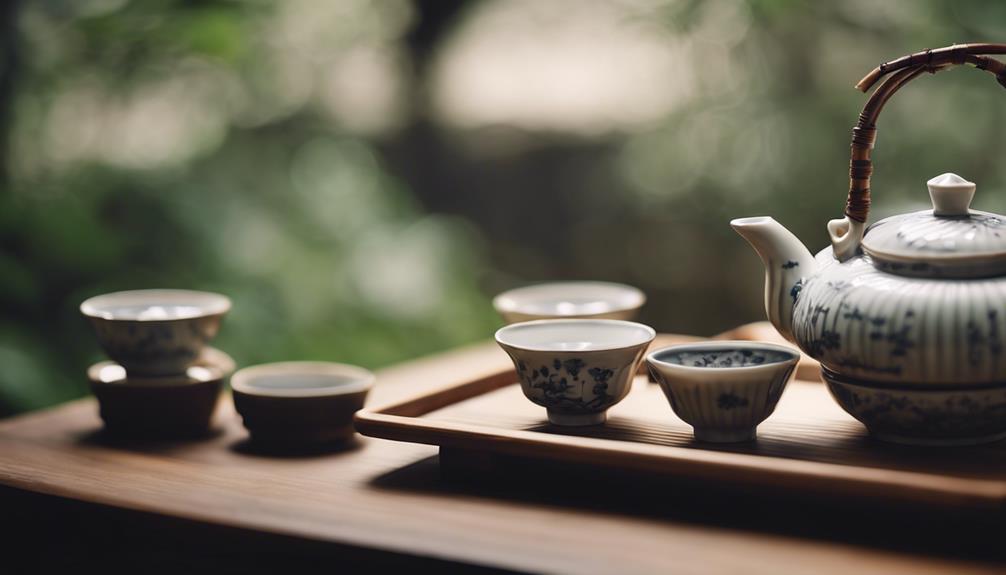
Crafted meticulously from a variety of materials, tea sets emphasize both durability and aesthetic appeal. Here are some considerations when choosing a tea set:
- Porcelain: Known for its delicacy and refinement, porcelain tea sets are prized for their elegance and beauty. The smooth texture and translucent quality of porcelain create a luxurious tea-drinking experience, perfect for special occasions or moments of tranquility.
- Cast Iron: Bold and sturdy, cast iron tea sets are celebrated for their excellent heat retention properties. The durability of cast iron ensures longevity, while the traditional designs add a touch of rustic charm to your tea rituals. Using a cast iron tea set can evoke feelings of strength and resilience with each brewing session.
- Bamboo: Offering an organic and eco-friendly option, bamboo tea sets provide a natural and minimalist aesthetic. The lightweight yet durable nature of bamboo makes it ideal for outdoor tea ceremonies or casual gatherings. Using a bamboo tea set can bring a sense of harmony and connection to nature to your tea-drinking experience.
Regional Tea Set Variations
When exploring the regional variations in Japanese tea sets, you'll encounter a rich tapestry of cultural influences manifested in their design and artistry. Each prefecture in Japan showcases its unique style of tea sets, blending traditional craftsmanship with local aesthetics.
For instance, the rustic Bizen ware tea sets hailing from Okayama prefecture exemplify simplicity and natural beauty through their earthy tones and unglazed surfaces. On the contrary, the vibrant Kutani tea sets from Ishikawa prefecture exhibit intricate hand-painted designs in bold colors, radiating an ornate and luxurious charm.
In Kyoto, renowned as the birthplace of the Japanese tea ceremony, you'll find the elegant Kyo ware tea sets distinguished by delicate patterns and refined forms. These regional variations not only enrich the tea-drinking experience but also offer a glimpse into the diverse cultural heritage of Japan.
Modern Influences on Tea Sets
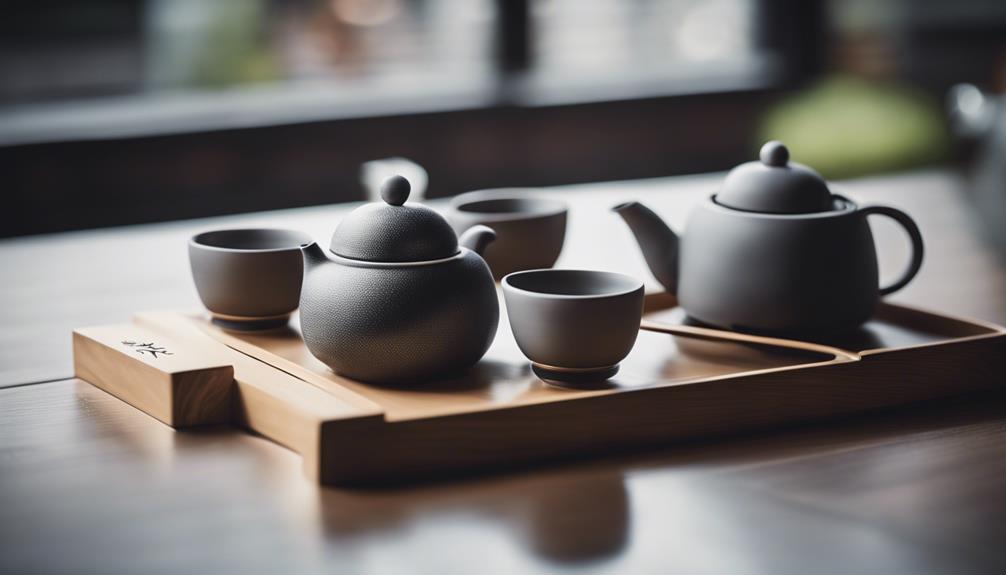
Modern influences have revolutionized the design of traditional Japanese tea sets, incorporating sleek lines and minimalist aesthetics. These contemporary trends respect time-honored craftsmanship while offering a fresh take on an ancient tradition.
Here are three ways modern influences have transformed Japanese tea sets:
- Sustainability: Modern tea sets prioritize eco-friendly materials and production methods, appealing to environmentally conscious tea enthusiasts. They use sustainable materials like bamboo, glass, or recycled ceramics, reducing their ecological footprint and promoting a greener lifestyle.
- Versatility: Contemporary tea sets blur the lines between traditional and modern uses by being multifunctional. They can serve as decorative pieces or even as serving ware, adding elegance to any space beyond the tea table.
- Innovative Technology: Some tea sets feature modern technology elements like temperature control systems or self-brewing mechanisms. These advancements enhance the tea-drinking experience, catering to tech-savvy individuals seeking convenience without compromising quality.
Collecting Japanese Tea Sets
Collecting Japanese tea sets offers a rich tapestry of design evolution and cultural appreciation, drawing enthusiasts into a realm of delicate artistry and historical significance. Delving into the world of Japanese tea sets unveils a diverse array of styles, each telling a unique story of craftsmanship and tradition.
To embark on your journey of collecting Japanese tea sets, it's crucial to define the focus of your collection. You may choose to specialize in a specific type, such as the elegant kyusu teapots, or opt for a more comprehensive approach that spans across various styles and eras. Researching the distinct styles of tea sets and their historical contexts can guide you in curating a collection that resonates with your interests and aesthetic preferences.
When scouting for Japanese tea sets to add to your collection, authenticity and condition are paramount considerations. Seek out marks or signatures from esteemed artisans or kilns to authenticate the pieces. Evaluating the quality and craftsmanship of the tea sets ensures that your collection not only holds material value but also embodies a deeper cultural significance.
Exploring avenues like auctions, antique stores, and online marketplaces can unveil hidden gems and rare finds to enrich your collection. Engaging in these treasure hunts not only adds to your collection but also deepens your understanding and appreciation of Japanese tea set artistry.
Embarking on the journey of collecting Japanese tea sets is a rewarding pursuit that allows you to immerse yourself in the beauty and heritage of these exquisite pieces. Each tea set holds a piece of history and craftsmanship, inviting you to savor the delicate artistry and cultural richness embedded within.
Tea Set Care and Maintenance
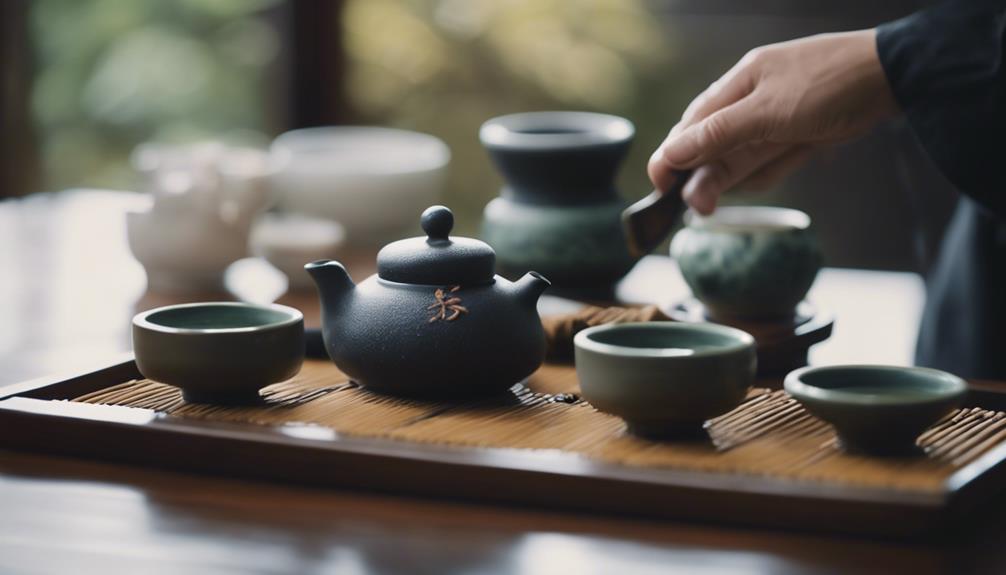
Caring for your Japanese tea set is crucial to maintain its beauty and functionality for years to come. Follow these key tips to ensure proper maintenance and enhance your tea-drinking experience:
- Handle with Care: It's recommended to hand wash your Japanese tea set using warm water and mild soap. Avoid harsh detergents and dishwashers to prevent damage to delicate designs and materials. This gentle approach allows you to admire the craftsmanship up close.
- Thorough Drying: After washing, ensure each piece is thoroughly dried to prevent water stains and mold growth. Use a soft, clean cloth to carefully dry both the inside and outside of the teapot, cups, and other components of the set.
- Proper Storage: When not in use, store your tea set in a cool, dry place away from direct sunlight. This helps maintain the colors and textures of the set, preserving its beauty over time.
Frequently Asked Questions
How Do You Choose the Perfect Tea Set for a Specific Type of Tea?
When exploring tea sets for specific types of tea, it's essential to consider various elements such as the material, size, and design to enhance your brewing experience. Tailoring the tea set to match the brewing requirements of the tea variety you prefer can elevate your enjoyment of the ritual. Embrace experimentation and immerse yourself in the art of brewing and relishing tea to fully appreciate the diverse flavors and aromas each cup offers.
Are There Any Superstitions or Taboos Associated With Using Certain Tea Sets?
When utilizing certain tea sets, you may come across superstitions or taboos associated with them. Some cultures believe that specific tea sets can bring ill fortune or should only be used during particular ceremonies or events. It is essential to honor and follow these traditional beliefs and practices while enjoying your tea.
What Is the Significance of the Color and Patterns on Japanese Tea Sets?
The intricate colors and patterns found on Japanese tea sets are imbued with deep symbolism and cultural significance. These artistic elements often reflect the beauty of nature, the changing seasons, and a range of human emotions. By appreciating and incorporating these design elements into your tea-drinking rituals, you can forge a stronger connection to Japan's rich history and enduring traditions.
Can Japanese Tea Sets Be Used for Purposes Other Than Tea Drinking?
Japanese tea sets are versatile items that can be used for various purposes beyond just tea drinking. They serve as beautiful decorative pieces, can store small trinkets or jewelry, and also function as elegant serving dishes for desserts or snacks. These sets encompass cultural aesthetics and practical functionality, making them a valuable addition to any home or event setting.
How Can I Properly Store and Display My Japanese Tea Set to Maintain Its Beauty?
For preserving the exquisite beauty of your Japanese tea set over time, it is essential to store and showcase it thoughtfully. Place the tea set in a clean and dry area, away from direct sunlight and moisture. To prevent any damage, use soft cloths or padding while handling and displaying it on a stable surface.
Ensure that the Japanese tea set is kept in a secure location, free from exposure to sunlight and dampness. Safeguard the delicate set by using gentle cloths or padding to avoid any scratches, and exhibit it proudly on a stable and level surface.
Conclusion
Delve into the intricate world of Japanese tea sets, where traditional kyusu blends with modern design influences.
The beauty and artistry of these tea sets showcase Japan's rich tea culture and the meticulous craftsmanship behind each piece.
Whether you're a collector or a tea enthusiast, understanding the history and regional nuances of Japanese tea sets enriches your tea-drinking experience.
Here's to savoring many more tea-filled moments in style!
